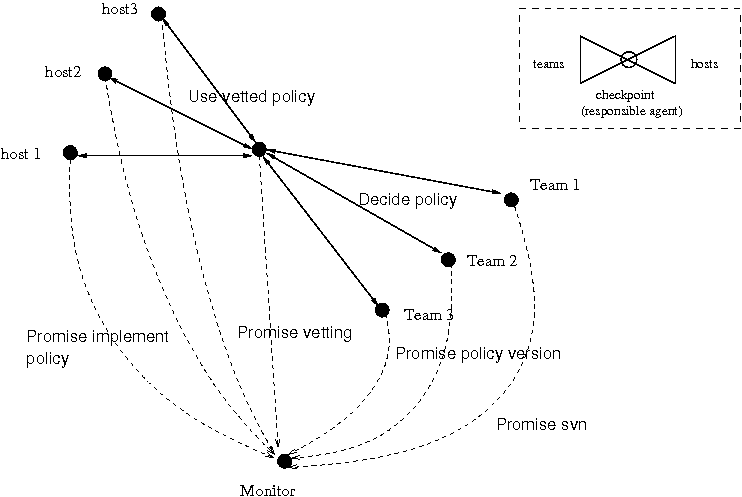
Team work is a collaboration between individuals with different skills. It is key element in decentralized organization – both for humans and computers.
Teams exist for efficiency (divide and conquer by skill) and also because because humans need continual motivation and emotional support which sustains work-flow and adds creativity to work.
The team-aspect of management is often overlooked in favour of top-down hierarchical design (do what the boss tells you). CFEngine does not force us into hierarchical systems however; the team analogy is more appropriate for CFEngine's model of voluntary cooperation.

IT management is complex, so it makes sense to delegate responsibility for different issues. An organization will generally consist of many groups and teams already, each with their own special needs and each craving its own autonomy. CFEngine and promise theory were designed for precisely this kind of environment. CFEngine allows cooperation and sharing without allowing central managers to ride roughshod over local needs.
Teams thrive by discussion and interaction within the framework of a policy or vision, allowing variation and arriving at a consensus when necessary. Success in a team depends on a combination of abilities working together not undermining one another. Conflicts in the promises made by team members reveal design problems in the group. An analysis of promises (CFEngine's model of collaboration) is a significant tool for understanding and enabling teams.
| Team work and policy design for inter-host cooperation are closely related. Use promises as a tool to explain to the individuals in a team which individual is responsible for what role, and to what extent. |
M. Belbin, a researcher in teamwork has identified nine abilities or roles (kinds of promise) to be played in a team collaboration (regardless of how many people there are in the team):
His model leaves little room for technical workflow arguments. It is entirely concerned with the creative process. This is probably significant. We should ask ourselves: how can we use the freedom to organize into specialized teams to maximize human creativity, while passing hard work over to machines. Solving this problem is what CFEngine is about.
We need to delegate responsiblity to divide and conquer a problem, both when designing policy for computers and when making work schedules for humans. But how can we be certain different parties will not interfere with one anothers' responsibilities? The bottom line is that we cannot be certain without oversight and coordination.
Promise theory shows that coordination needs a single point of coordination to be the arbiter of correctness in any collaborative process: a so-called `checkpoint' or `team leader', like passport control at an airport. This checkpoint has to examine each contribution to the team and look for conflicts.
For humans, this might be a matter of communication by meeting. CFEngine, on the other hand, has no built-in meta-access control mechanism which can decide who may write policy rules. To create such a mechanism, there would have to be a monitor which could identify users, and an authority mechanism that would disallow certain users to write rules of certain types about certain objects on certain hosts.
CFEngine Community Edition has roles promises, which offer a
partial solution, but it does not address the core issue which is that
collaboration in change requires freedom to act, not restriction.
Delegation therefore requires trust. CFEngine Nova/Enterprise
has `hubs' which can be coordinate large numbers of
hosts. Coordination can also be pre-arranged as policy, so that
everyone has their own copy of the script. This is how an orchestra
scales, for instance.
To keep matters as simple as possible, CFEngine avoids this kind of technical coordination as much as possible and proposes a different approach, using policy along with a social contract between the collaborating teams. Promise theory allows us to model the collaborative security implications of this (see the figure of the bow-tie structure). A simple method of delegating is the following.
A review procedure for policy-promises is a good solution if you want to delegate responsibility for different parts of a policy to different sources. Human judgement as the `arbiter' is irreplaceable, but tools can be added to make conflicts easier to detect.
Promise theory underlines that, if a host or computing device accepts policy from any source, then it is alone and entirely responsible for this decision. The ultimate responsibility for the published version policy is the vetting agent. This creates a shallow hierarchy, but there is no reason why this formal body could not be comprised of representatives from the multiple teams.
The figure below shows how a number of policy authoring teams can work together safely and securely to write the policy for a number of hosts, by vetting through a checkpoint, in a classic `bow-tie' formation.
